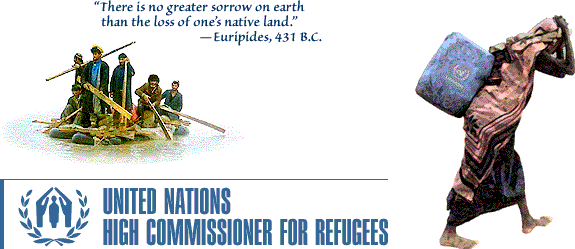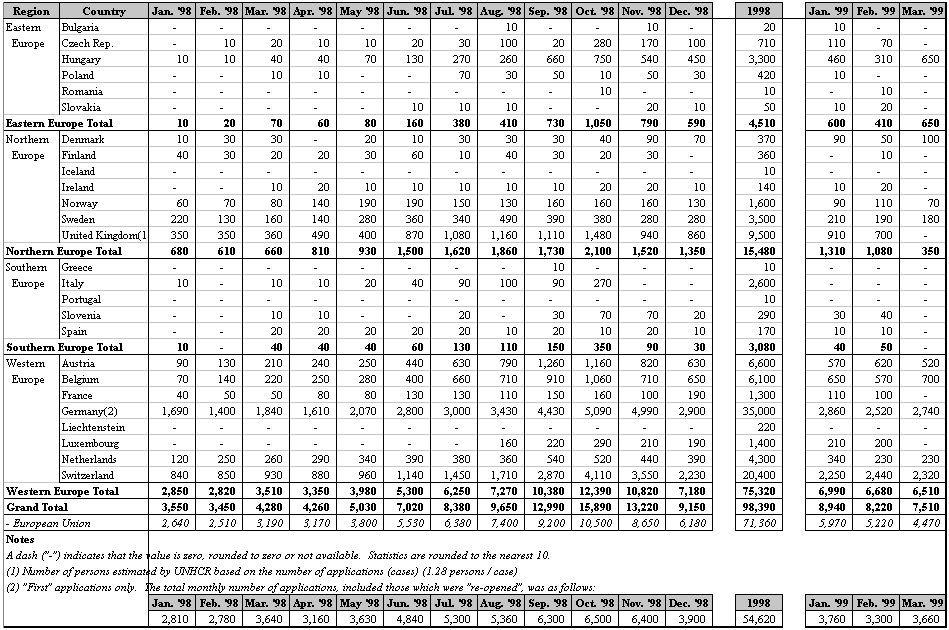AT A GLANCE
- Negotiations continue for the entry of refugees stranded in
the mountains between Kosovo and the FYR of Macedonia. Preparation of new refugee camp
site at Cegrane underway.
- Some displaced Kosovars arrive in Montenegro, while greater
numbers continue to leave Montenegro for Albania.
- The estimated total numbers of refugees in the region are
359,000 in Albania, and 132,100 in the FYR of Macedonia. An additional 68,200 displaced
Kosovars remain in Montenegro.
MAJOR DEVELOPMENTS
ALBANIA
A lone trailer truck crossed the main Morini border
Wednesday, carrying 130 refugees. The refugees came from Istok and said they had walked
for five days to reach the small town of Zrze, in the municipality of Prizren, where they
spent one night before being told to leave. They said they had met several other large
groups of people moving towards the border area during their journey. Early on Thursday,
another 650 crossed.
UNHCR is intensifying efforts to transfer refugees from
the Kukes area to other parts of Albania, because of the precarious security situation in
the border area and the need to free up places for refugees who may arrive in large
numbers. An information campaign is underway to explain to refugees why they should agree
to move out of the area. 8,000 refugees were transferred by road to sites in the south
yesterday. The cumulative number of refugees reported by the authorities to have been
moved south is 212,200, but UNHCR believes more have travelled south in private vehicles
and taxis. In addition, a NATO helicopter lift from Kukes yesterday carried four families,
totalling 79 refugees, to the town Peshkopi.
The majority of refugees who have been transferred from
Kukes to southern prefectures are still living in temporary accommodation prepared by
local authorities, including sports halls and schools. An estimated 100,000 are living in
various types of private accommodation, including with host families.
UNHCR, IOM and the Albanian government are proceeding with
plans for a general registration of all refugees in Albania. The goal is to complete this
huge exercise by the end of May.
It is estimated that 80 to 100 NGOs of all nationalities
and sizes are now providing assistance to refugees throughout the country. UNHCR has
recently conducted a survey to identify gaps in the provision of assistance and is
coordinating NGO efforts to cover these gaps. An NGO Information Center is scheduled to
open soon, funded by the International Rescue Committee, to help with information sharing.
FYR of MACEDONIA
There were no new arrivals of refugees reported at the
border with the FYR of Macedonia on Wednesday, though the remaining 800 refugees who had
been stranded in no man’s land near Lojane were allowed to enter early on 21 April.
They were transported to the Neprosteno camp. As of Thursday morning, it was reported that
no further refugees were in the Lojane no man’s land area.
Between 6,000 and 8,000 refugees are still reported to be
staying —some of them without shelter— in and around the remote mountain village
of Male Malina (also called Malina Mala). A UNHCR team and two trucks carrying blankets
and food were dispatched to the area yesterday, but were not permitted to proceed by the
authorities. UNHCR in Skopje is continuing negotiations with authorities for the entry of
this group.
The transfer into the country of over 5,000 refugees who
entered at Lojane over the past three days has placed extreme pressure on camp
infrastructures and services. Camps are full to capacity. Top priority is being given to
construction of the new camp at Cegrane. A UN/NGO Emergency Task Force has been
established in Skopje to tackle the problems of overcrowding in the camps, the new
influxes of refugees and the delivery of assistance.
UNHCR health teams have reported that the medical
situation of the estimated 45,600 refugees in camps appears to be stable, with low levels
of mortality and no evidence of major outbreaks of disease. However, sanitation and water
systems are operating at maximum capacity due to the overcrowding, and UNHCR fears they
may soon be insufficient to meet demands.
MONTENEGRO
On Wednesday two groups of displaced Kosovars are reported
to have arrived in Montenegro. One group of 200 displaced persons are reported to have
arrived in Montenegro (Rozaje) from the Rugova valley area west of Pec. They said that
many more were on the way. The new arrivals came from the villages of Kuciste, Maljevic,
Pepic and Drelje. In addition, it was learned mid-morning on Thursday that 300 people had
arrived by bus through the Zeleni checkpoint. They reportedly came from Izbica, in the
Drenica region, and reported that they had left there on 18 April and walked to Jablanica,
where they were put on buses to Tutin, 32 km from Rozaje. From Tutin the Serbian police
reportedly organized their travel to Rozaje.
Meanwhile twenty buses carried 2,000 displaced Kosovars
from Montenegro to Albania during the day of 21 April.
Tension remains high in and around the municipality of
Rozaje. Some local residents of Albanian origin are sending their family members to other
areas of Montenegro which are considered safer. In addition, four buses were observed
leaving Rozaje for Bosnia and Herzegovina. The passengers were local Muslims from Rozaje
as well as persons from Tutin and other areas of the Sandzak region.
The Yugoslav army opened a new check point on the road
between Rozaje and Kosovo and UNHCR is concerned that this may prevent displaced people
from moving into Montenegro. Tension is also reported to be on the rise in Ulcinj, which
is sheltering around 25,000 displaced Kosovars.
On the assistance front: CARE’s fresh food program is
being expanded to cover transit centres for new arrivals in Ulcinj, Rozaje and Tuzi. In
Ulcinj yesterday UNHCR distributed blankets in the Neptune camp, MSF and SAH are setting
up more tents and Caritas Italy is opening an office. Food parcels from World Vision have
arrived there. UNHCR also dispatched blankets, soap, jerrycans, sanitary supplies and
mattresses to Tuzi yesterday to help the authorities accommodate new arrivals from Rozaje.
ICRC food parcels were distributed and MCI purchased and distributed food. 10 mt of WFP
wheat flour have been delivered to a bakery in Tuzi to bake bread for the displaced.
HUMANITARIAN EVACUATION PROGRAM
On Wednesday 21 April, 402 refugees were flown out of
Skopje to Belgium, Poland and Turkey. Flights to Austria, France and Turkey are scheduled
for today.
UNHCR and IOM have completed the registration of the
refugee populations in the transit camps of Stankovac I and II, greatly facilitating the
identification of refugees for evacuation. The registration includes information on
vulnerable refugees and those with missing relatives, as well as on links abroad.
Separated relatives are being located and reunited. In one
case, a woman who fled Kosovo with her five children was separated from two of them, a
daughter of 15 and a son of 13, on 5 April when they were forced onto buses at the Blace
border crossing and taken into the FYR of Macedonia. Their mother and brothers and sisters
were meanwhile put onto a plane bound for Turkey where they were transferred to the
Kirklareli refugee camp. Upon learning the story, UNHCR staff in Turkey immediately got in
touch with the UNHCR humanitarian evacuation team in Macedonia. Thanks to the completion
of the registration exercise at Stankovac, the missing children were quickly located and
were flown to Turkey yesterday for an emotional reunion with their mother and siblings.
|


 Document compiled by Dr S D Stein
Document compiled by Dr S D Stein